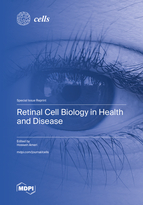Retinal Cell Biology in Health and Disease
A special issue of Cells (ISSN 2073-4409). This special issue belongs to the section "Cellular Pathology".
Deadline for manuscript submissions: closed (31 August 2023) | Viewed by 38493
Special Issue Editor
Special Issue Information
Dear Colleagues,
The retina is composed of several layers with highly specialized cells. In the outer retina, rod and cone photoreceptors transduce light stimulus into an electrophysiological signal. In the middle of the retina, bipolar cells transmit signals from the photoreceptors to the ganglion cells through a complex process that is modulated by amacrine cells and horizontal cells. In the inner retina, the processed signals are transferred from the eye to the brain through the long axons of the ganglion cells. Other cells, such as retinal pigment epithelial cells and Muller cells, play an essential supporting role. Any interference with this sophisticated signal processing, at any level, could result in visual impairment. This could occur through a myriad of acquired and inherited conditions in which chemical dysregulations may or may not be associated with structural changes.
This Special Issue aims to expand our understanding of the role of the retina in physiological and pathological conditions. The following are some examples of topics of interest:
- Signal processing in the retina;
- The impact of diseases on the retina;
- The effect of various treatments on the retina;
- Metabolic status of the retina;
- Retinal gene modifications;
- Retinal cell transplantation.
Dr. Hossein Ameri
Guest Editor
Manuscript Submission Information
Manuscripts should be submitted online at www.mdpi.com by registering and logging in to this website. Once you are registered, click here to go to the submission form. Manuscripts can be submitted until the deadline. All submissions that pass pre-check are peer-reviewed. Accepted papers will be published continuously in the journal (as soon as accepted) and will be listed together on the special issue website. Research articles, review articles as well as short communications are invited. For planned papers, a title and short abstract (about 100 words) can be sent to the Editorial Office for announcement on this website.
Submitted manuscripts should not have been published previously, nor be under consideration for publication elsewhere (except conference proceedings papers). All manuscripts are thoroughly refereed through a single-blind peer-review process. A guide for authors and other relevant information for submission of manuscripts is available on the Instructions for Authors page. Cells is an international peer-reviewed open access semimonthly journal published by MDPI.
Please visit the Instructions for Authors page before submitting a manuscript. The Article Processing Charge (APC) for publication in this open access journal is 2700 CHF (Swiss Francs). Submitted papers should be well formatted and use good English. Authors may use MDPI's English editing service prior to publication or during author revisions.
Keywords
- Retina
- photoreceptors
- retinal pigment epithelium
- retinal vascular diseases
- inherited retinal diseases
- gene therapy
- stem cell transplantation
- retinal imaging
- angiogenesis







